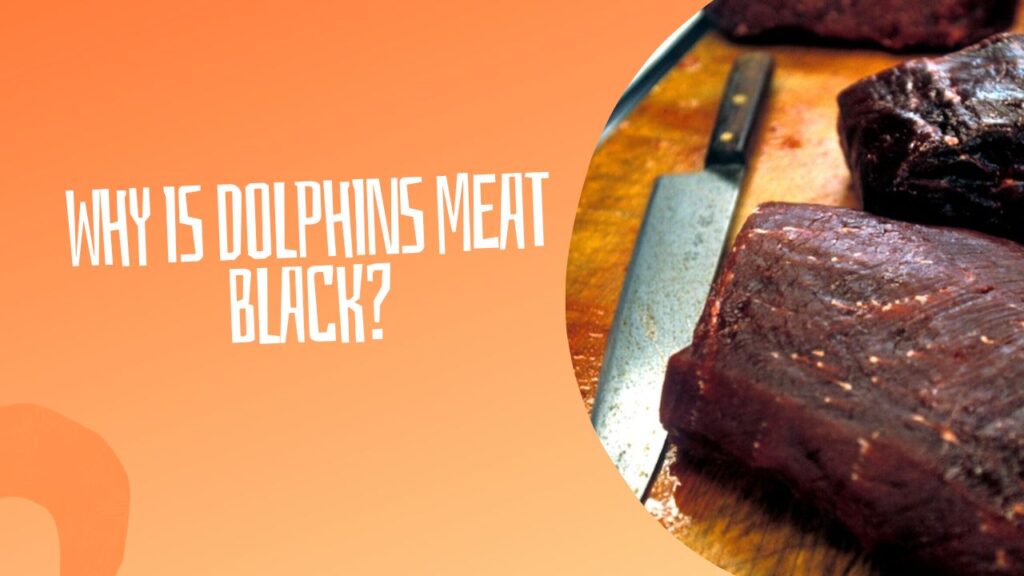Last updated on October 12th, 2023 at 09:18 am

Picture yourself sitting at a waterfront restaurant, enjoying a picturesque sunset while savoring an exotic dish that few have experienced.
Now imagine that dish is made from none other than bottlenose dolphin – one of the most beloved marine creatures in our oceans. The idea may seem shocking and repulsive to some, while intriguingly adventurous to others.
Join us on this culinary exploration as we delve into the taboo topic “can you eat bottlenose dolphin”: its historical roots, legal implications around the world, and whether it’s something we should even consider in our increasingly conscious society.
Table of Contents
- 1 Can You Eat Bottlenose Dolphin?
- 2 What Does Bottlenose Dolphin Taste Like?
- 3 What Kind Of Dolphin Do We Eat?
- 4 Why Is Dolphins Meat Black?
- 5 What Countries Eat Dolphins?
- 6 It Is Illegal To Eat Dolphin?
- 7 Dolphin Meat Called?
- 8 Frequently Asked Questions (FAQs)
- 8.1 Can You Eat Bottlenose Dolphin?
- 8.2 Why Is It Illegal To Eat Bottlenose Dolphin?
- 8.3 Are There Any Health Risks Associated With Eating Bottlenose Dolphin?
- 8.4 Is There Any Cultural Significance Related To Eating Bottlenose Dolphin?
- 8.5 Are There Alternative Sources Of Seafood That Taste Similar To Bottlenose Dolphin?
- 9 Conclusion
Can You Eat Bottlenose Dolphin?
Bottlenose dolphins, famed for their playful personalities and high intelligence, are not widely consumed as food for various reasons. Eating them would generally be discouraged for several reasons.
Firstly, they are protected in many countries thus hunting or eating them would likely be illegal.
However, these marine mammals also play an integral part in maintaining marine ecosystems as they act as predators that control various fish populations in marine waters.
Secondly, bottlenose dolphins have been reported as gathering contaminants such as heavy metals and toxins from their environments, potentially increasing health risks such as mercury poisoning or ingestion of other harmful materials.
Consuming these contaminated creatures could put humans at risk from mercury exposure or ingestion of other harmful materials.
Due to their intelligence and social behavior, dolphins are seen by many people as living beings who deserve respect and protection, rather than simply as food sources. Due to this they make popular subjects for research efforts as well as conservation projects.
Overall, while it may technically be feasible to consume bottlenose dolphin meat, such action is ethically dubious and pose significant health risks.
Therefore, it would be more prudent and respectful of this incredible marine life to appreciate them in their native environments rather than consider them for consumption as food options.
What Does Bottlenose Dolphin Taste Like?
Bottlenose dolphin meat has often been likened to that of steak or pork for its versatility and adaptability in culinary techniques, from pan-searing and grilling, through adding it as an ingredient in stews or soups – its high protein content making it a nutritious source.
It is crucial to remember that dolphin meat consumption is debatable due to conservation efforts and worries about mercury levels in their flesh. As a result, the hunting and selling of dolphin meat are subject to stringent laws in many nations.
What Kind Of Dolphin Do We Eat?
When it comes to consuming dolphins, not all species are consumed. The most common dolphin species that humans eat is the pilot whale. Pilot whales may often be mistaken for dolphins due to their similar appearance; they belong to the dolphin family and can even be considered delicacies in some countries.

In Japan, for example, pilot whaling has been a cultural practice for centuries. The meat from these marine mammals is used in traditional dishes like sashimi and sliced into thin pieces as part of various recipes. Despite controversy surrounding the ethics of hunting these intelligent creatures, there remains a demand for their meat in certain regions.
Outside of Japan and other limited countries where it is consumed, dolphins are mainly protected by laws and regulations that prohibit their hunting and sale. These protective measures are implemented due to numerous conservation concerns and recognizing dolphins’ high levels of intelligence and social behavior.
Dolphin meat itself presents health risks to humans due to its elevated levels of mercury and other contaminants. Some studies have found that such consumption can even lead to symptoms resembling mercury poisoning.
With increasing awareness about animal welfare, environmental conservation, and health risks associated with consuming dolphin meat, the global demand for this specific type of food has considerably decreased over time.
See Also: Are Dolphins Safe To Eat? The Truth About Consuming Dolphins
Why Is Dolphins Meat Black?

Dolphins are known for their sleek and shiny appearance, but have you ever wondered why their flesh is often black? The unusual coloration of dolphin meat can primarily be attributed to the myoglobin pigment present in their muscles. Myoglobin is a protein that helps to store oxygen in muscle tissues.
Dolphins differ from terrestrial mammals by possessing higher myoglobin concentrations in their muscles, giving them better oxygen storage capabilities during prolonged swimming and deep dives. This natural adaptation allows dolphins to endure extended periods underwater and perform agile movements.
The high concentration of myoglobin contributes to the dark color of dolphin meat. When cooked, the myoglobin reacts with heat resulting in a visually striking shade of black or dark red. These pigments are harmless and do not affect the taste or texture of the meat.
Noting the cultural norms and conservation efforts to safeguard dolphins as intelligent marine organisms is rare, however. Furthermore, black-colored dolphin meat is not common on seafood menus or in food markets as other marine animals like fish tend to be more commonly consumed.
While the mysterious darkness of dolphin meat may capture our curiosity, it should be remembered that these captivating marine creatures are most appreciated for their intelligence, beauty, and vital role in ocean ecosystems rather than being considered as sources of culinary delicacies.
What Countries Eat Dolphins?
There are a few nations where dolphin ingestion has been documented. One such nation is Japan, where some coastal towns occasionally eat dolphin meat. For their meat and blubber, these regions have a long history of hunting tiny cetaceans like dolphins.
In the South Pacific Ocean, the Solomon Islands are another nation where dolphin ingestion has been documented. Dolphins are hunted and their meat is prized in some of this island nation’s rural towns.
It’s crucial to remember that, despite the possibility of dolphin consumption in these nations, it is not a widespread cultural practice.
Due to environmental and animal welfare considerations, most residents in these nations do not consume dolphin meat as part of their cuisine – there have even been international protests against this practice.
It Is Illegal To Eat Dolphin?
In many countries, it is illegal to eat dolphin. These intelligent marine mammals are protected by various laws and regulations due to concerns about their conservation status and welfare.
Consumption of dolphin meat is seen as unethical and inhumane, given the cognitive abilities and social nature of these creatures.
United States law strictly forbids eating dolphin, and violators can face steep fines or even imprisonment for breaking this rule.
Under its Marine Mammal Protection Act, hunting, possessing, selling and hunting of any dolphin products and derivatives derived thereof is illegal under law. This includes possession, sale or even hunting activities that take place.
The ban extends beyond just consuming dolphin meat; it also covers their byproducts such as oil, organs, skins, and teeth. This comprehensive approach aims to discourage any commercial exploitation or trade that could potentially harm these vulnerable species.
International treaties like the Convention on International Trade of Endangered Species (CITES) provide additional safeguards to dolphins. CITES regulates international commerce for certain animal species to help guarantee their survival in nature.
While some argue that cultural practices involving dolphin consumption should be respected, governments prioritize the preservation of these magnificent creatures. Dolphins play a crucial role in marine ecosystems by maintaining biodiversity and ecological balance.
Dolphin Meat Called?

Dolphin meat is commonly referred to as mahi-mahi in the culinary world. Derived from the Hawaiian language, mahi-mahi means strong, which perfectly embodies the powerful and captivating nature of dolphins.
This delicious fish has gained immense popularity for its firm texture and mild flavor, making it a favorite among seafood enthusiasts across the globe.
The mahi-mahi fish can be easily recognized by its vibrant colors – bright blues and greens blended with gold, resembling the stunning patterns found on dolphins.
These features have led to its colloquial name dolphinfish. However, it is crucial to differentiate between the two species as mahi-mahi fish are entirely distinct from the marine mammals known as dolphins. This differentiation ensures there is no confusion or ethical concerns surrounding consumption.
Due to its versatility, dolphin meat plays a vital role in various cuisines worldwide. Whether grilled, baked, or used in ceviche, mahi-mahi adds an exquisite touch to any dish. Its lean and flaky flesh lends itself well to numerous cooking methods while allowing flavors from marinades and spices to infuse seamlessly.
Chefs often praise mahi-mahi as providing them with ample creative freedom when it comes to culinary endeavors. Grilled mahi-mahi pairs well with tropical fruit salsas or tart citrus glazes for an ideal blend of sweet and tart flavors, or marinate it first in aromatic herbs and spices for even deeper depth of flavors!
Dolphin meat provides multiple nutritional advantages beyond being simply tasty. As it provides ample amounts of protein while being low in saturated fats, dolphin is an ideal option for health-minded consumers looking for leaner alternatives in their diets.
Furthermore, its essential vitamins and minerals like B-12 and selenium all play important roles in overall wellbeing.
See Also: What Does Dolphin Meat Looks Like and Should We Eat It?
Frequently Asked Questions (FAQs)
Can You Eat Bottlenose Dolphin?
No, it is illegal to consume or sell any part of a bottlenose dolphin in most countries.
Why Is It Illegal To Eat Bottlenose Dolphin?
Bottlenose dolphins are protected species due to their high intelligence and conservation status.
Are There Any Health Risks Associated With Eating Bottlenose Dolphin?
Yes, consuming dolphin meat can be dangerous as it may contain high levels of mercury and other toxins.
Is There Any Cultural Significance Related To Eating Bottlenose Dolphin?
While some cultures historically consumed dolphins, today it is generally frowned upon due to conservation efforts and ethical considerations.
Are There Alternative Sources Of Seafood That Taste Similar To Bottlenose Dolphin?
Many types of fish, such as mahi-mahi or snapper, have a similar texture and taste profile to dolphin meat.
Conclusion
Although technically possible to consume bottlenose dolphin meat, ethical and environmental issues must also be carefully considered before doing so.
Dolphins are highly intelligent marine animals who play an essential part in marine ecosystems; therefore, their consumption could have dire repercussions for both their population and for maintaining equilibrium in our aquatic environment.
Furthermore, methods used to capture and kill dolphins for consumption often employ cruel practices that violate animal welfare standards.
We as consumers have an ethical responsibility when choosing our diet; let us appreciate these magnificent animals in their natural environments instead of contributing to their exploitation by eating them!

Mr. Das, a certified pharmaceutical scientist, holds a Bachelor of Science in Pharmaceutical Sciences and passionately contributes to dolphin conservation as a member of the committee in Bangladesh.


